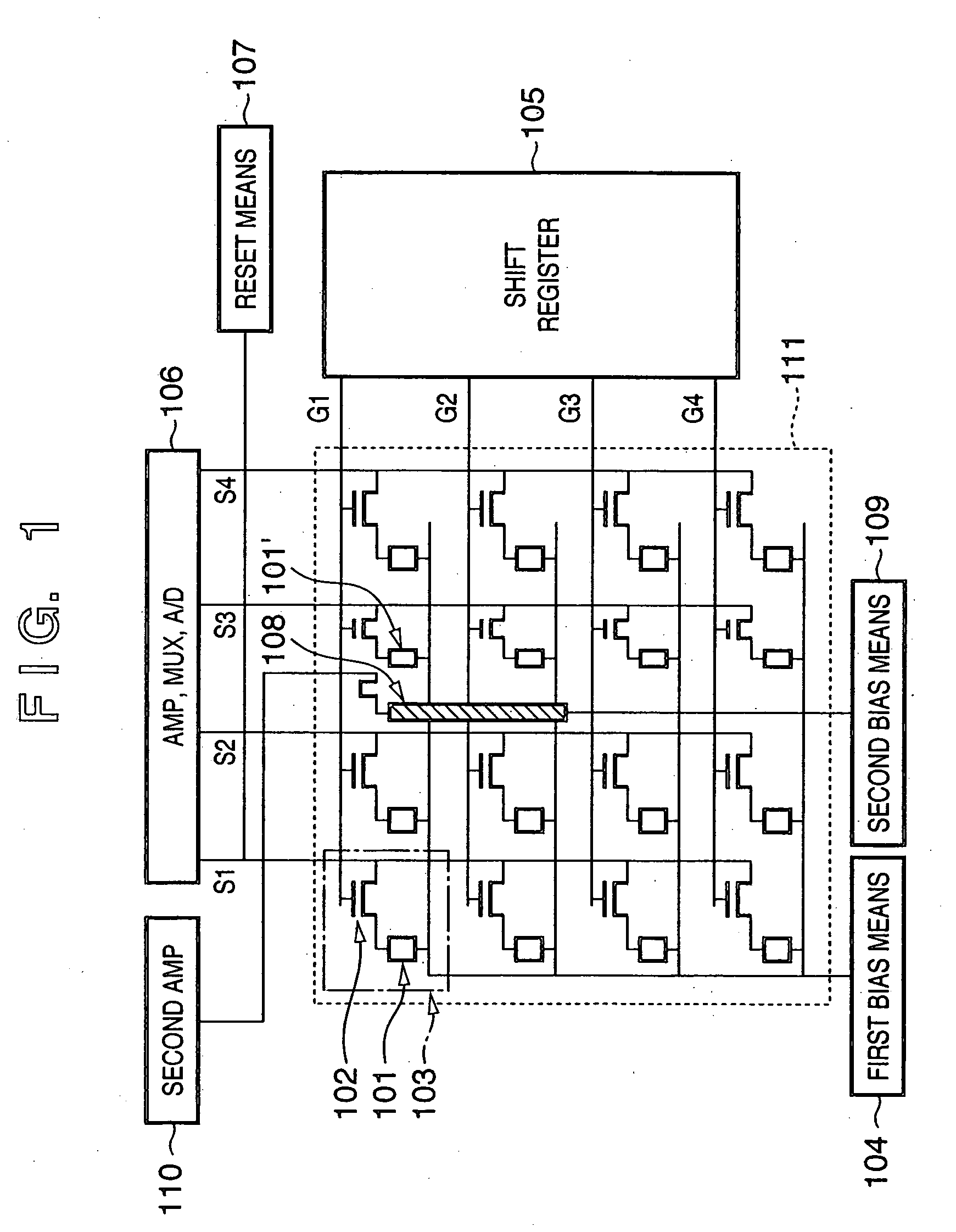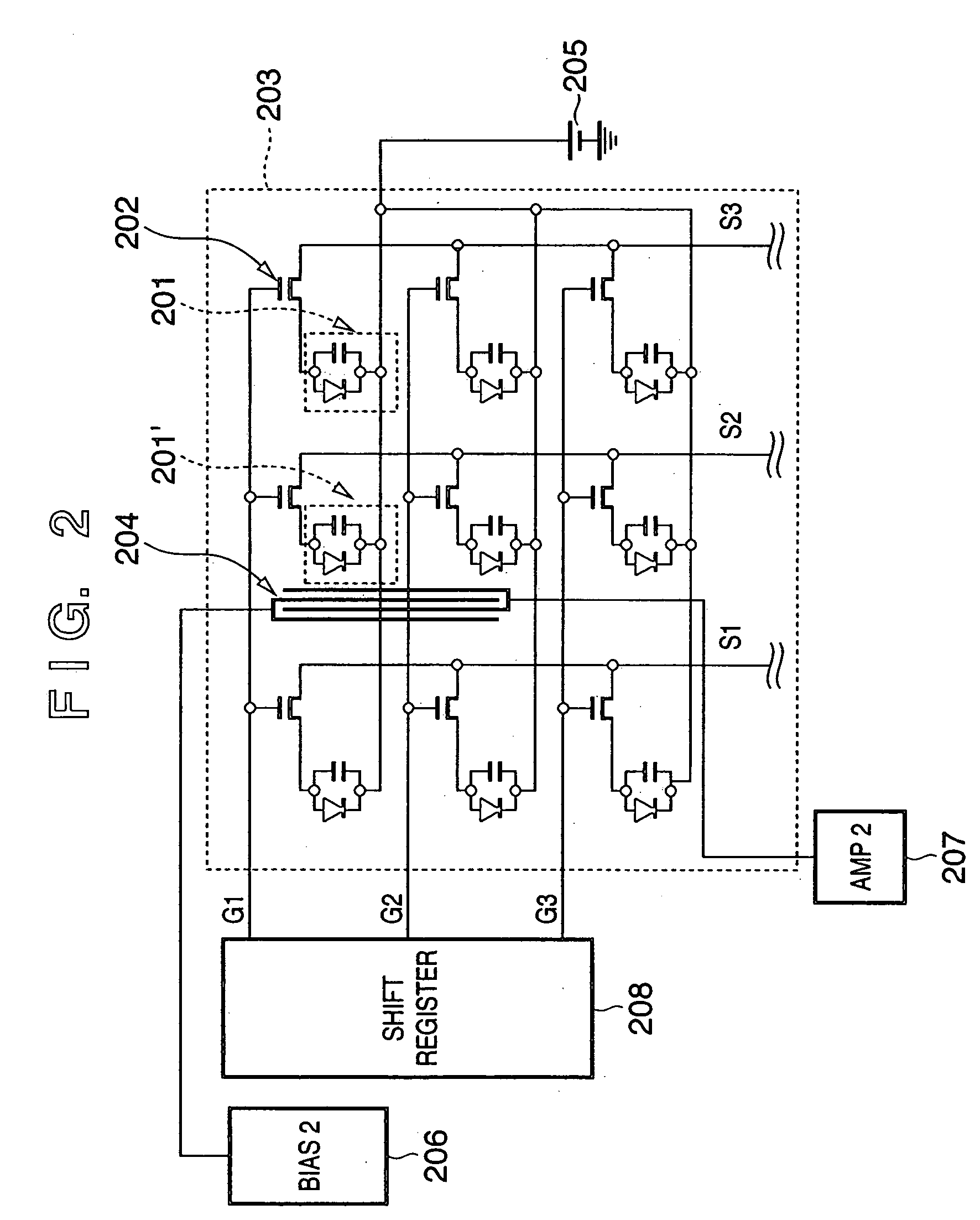Radiation image sensing apparatus and its driving method
a sensing apparatus and imaging technology, applied in the direction of radioation control devices, instruments, television systems, etc., can solve the problems of poor image quality of sensed images, increased overall apparatus cost, and poor layout of aec control sensors
- Summary
- Abstract
- Description
- Claims
- Application Information
AI Technical Summary
Benefits of technology
Problems solved by technology
Method used
Image
Examples
first embodiment
[0057] The first embodiment of the present invention will be described below with reference to FIG. 1.
[0058]FIG. 1 is a circuit diagram of a radiation image sensing apparatus of this embodiment. As shown in FIG. 1, the radiation image sensing apparatus of this embodiment comprises a 2D matrix of a total of 16 pixels 103, i.e., 4 cells in the vertical direction×4 cells in the horizontal direction. Each pixel 103 comprises a first photoelectric conversion element 101, and a transistor 102, which is connected to the element 101 and serves as a transfer switch element.
[0059] The first photoelectric conversion elements 101 are connected to a first bias means 104, and the gates of the transistors 102 are connected to a shift register 105 via gate lines G1 to G4 for respective rows. Output signals of the transistors 102 are transferred to an amplifier / multiplexer / A / D converter 106 via signal lines S1 to S4 for respective columns, and undergo signal processes in turn. A reset means 107 is...
second embodiment
[0068] The second embodiment of the present invention will be described below with reference to FIG. 2 and FIGS. 3A and 3B.
[0069]FIG. 2 is a circuit diagram of a radiation image sensing apparatus of this embodiment. FIGS. 3A and 3B are respectively a plan view and sectional view of building components corresponding to one pixel of the radiation image sensing apparatus; FIG. 3A is a plan view, and FIG. 3B is a sectional view taken along a broken line A-B in FIG. 3A.
[0070] In this embodiment, each first photoelectric conversion element 201 has a PIN structure. Each switch element 202 is formed by a TFT (thin film transistor). The gates of the switch elements 202 are connected to a shift register 208 via gate lines G1 to G3. Output signals from the switch elements 202 are externally output via signal lines S1 to S3.
[0071] A second photoelectric conversion element 204, which has an elongated shape compared to the first photoelectric conversion elements 201 used to read out a normal i...
third embodiment
[0085] The third embodiment of the present invention will be described below with reference to FIG. 4 and FIGS. 5A and 5B.
[0086]FIG. 4 is a circuit diagram of a radiation image sensing apparatus of this embodiment. FIGS. 5A and 5B are respectively a plan view and sectional view of building components corresponding to one pixel of the radiation image sensing apparatus; FIG. 5A is a plan view and FIG. 5B is a sectional view. In this embodiment, a first photoelectric conversion element 401 has an MIS structure, and a switch element 402 comprises a TFT.
[0087] In this embodiment as well, first photoelectric conversion elements 401′ which neighbor a second photoelectric conversion element 403 have an area smaller than those of other first photoelectric conversion element 401.
[0088] The second photoelectric conversion element 403 is connected to a second bias power supply (Bias2) 206, need not be selected by a shift register 208 upon reading out a charge, and is always applied with a bi...
PUM
 Login to View More
Login to View More Abstract
Description
Claims
Application Information
 Login to View More
Login to View More - R&D
- Intellectual Property
- Life Sciences
- Materials
- Tech Scout
- Unparalleled Data Quality
- Higher Quality Content
- 60% Fewer Hallucinations
Browse by: Latest US Patents, China's latest patents, Technical Efficacy Thesaurus, Application Domain, Technology Topic, Popular Technical Reports.
© 2025 PatSnap. All rights reserved.Legal|Privacy policy|Modern Slavery Act Transparency Statement|Sitemap|About US| Contact US: help@patsnap.com



